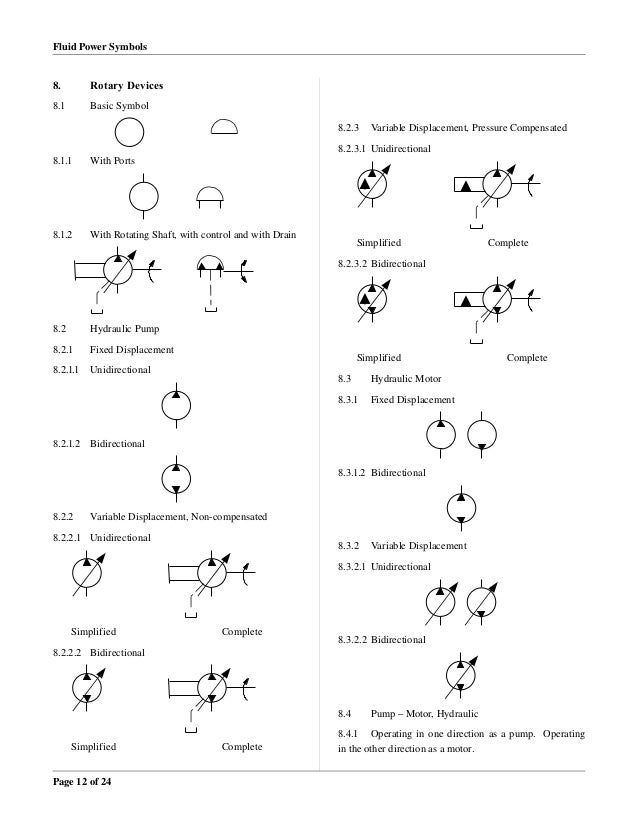Iso Symbol For Fluid Power
1 G e n e r a l Fluid power systems are those that transmit and control power through use of a pressurized fluid (liquid or gas) within an enclosed circuit. T ype s of sym bol s com mon ly use d in dra win g cir cui t diagrams for fluid power systems are Pictorial, Cutaway, and Graphi c. These symbo ls are full y expla ined in the USA Standard Drafting Manual (Ref. 1.1.1Pi ctoria l symbol s are very usefu l for showing the int erc onne cti on of com pone nts. The y are diffi cul t to standardize from a functional basis.
- Fluid Power Symbols 2. Symbol Rules 2.1 Symbols show connections, flow paths, and functions of components represented. They can indicate.
- International Fluid Power Conference Extends Call for Papers. Sep 29, 2006. ISO Symbols and Glossary, part 2. Bud Trinkel Sep 28, 2006.
CETOP, RP68P, ISO 5599 (Pneumatics) Fluid power diagrams. APPLICATIONS OF PNEUMATICS AND HYDRAULICS.
Iso Symbol For Hammer Union
1.1.2 Cuta way symbol s emphas ize const ructio n. These symbols are complex to draw and the functions are not readily apparent. 1.1.3 Graphi c s ymbol s em phasiz e t he functi on a nd methods of operation of components. These symbols are simp le to draw. Compon ent funct ions and metho ds of opera tion are ob vious. Graphi c symbols are ca pable of crossing language barriers, and can promote a universal understanding of fluid power systems. Graphic symbols for fluid power systems should be used in conjunction with the graphic symbols for other systems published by the USA Standards Institute (Ref.
3-7 inclusive). 1 Compl ete graph ic symbo ls are those, which giv e symbolic representation of the component and all of its features pertinent to the circuit diagram. 1.1.3.2 Simpl ified graphic symb ols are styl ized vers ions of the complete symbols. 1.1.1.3 Compos ite graphic sym bols are an orga nizat ion of simpl ified or complet e symbols.
Compos ite symbol s usually represent a complex component. 1.2 Sc o pe a nd Pu rp os e 1. 2.1 Scope – Thi s sta ndard prese nts a sys tem of graphic symbols for fluid power diagrams. 1 Elementary forms of symbols are: C i r c l e s R e c t a n g l e s A r c s D o t s Sq ua re s T ri an g le s Ar ro ws Cr os se s Symbols using words or their abbreviations are avoided. Symbols capable of crossing language barriers are presented herein. Compon ent function rather than const ruction is emphasized by the symbol. 1.4 The means of ope ratin g fluid pow er compo nents are shown as part of the symbol (where applicable).
1.5 This stan dard sho ws the basic sy mbols, des cribes the principle s on which the symbols are based, and illu strat es some repr esenta tive compos ite symbo ls. Composite symbols can be devised for any fluid power component by combining basic symbols.
Simplified symbols are shown for commonly used components. 1.6 This standard pro vides basic symbols, which differentiate between hydraulic and pneumatic fluid power media. 1 Sym bol s sho w con nec tio ns, flo w pat hs, and funct ions of componen ts represe nted. They can indica te conditions occurring during transition from on flow path arrangement to another.
Symbols do not indicate construction, nor do they indicate values, such as pressure, flow rate, and other component settings. 2. The business 2005 torrent. 2 Sym bol s do not ind ica te loc ati ons of port s, direction of shifting spools, or positions of actuators on actual components. 2.3 Sym bol s ma y be ro tate d or re ve rse d with out altering their meaning except in the cases of: a.) Lines to Reservoir, 4.1.1; b.) Vented Manifold, 4.1.2.3; c.) Accumulator, 4.2. May be shown an y suitable size. Size may be varied f or emphasis or clarity. Relative si zes should be maintained. (As in the f ollowing e xample.) 2.5.1 Cir cle and Sem i-C irc le 2.5.

1.1 Larg e and small circl es may be used to signi fy that one component is the “main” and the other the auxiliary. 2 T ri an gl e 2.5. 3 A rr o w 2. 4 Sq ua r e Rectangle 2. 6 Le tt er c om bi na ti on s us ed a s pa rt s of gr ap hi c symbols are not necessarily abbreviations.
2.7 In mul tip le en ve lop e sym bol s, the flo w cond iti on shown nearest an actuator symbol takes place when that control is caused or permitted to actuate. 2.8 Eac h sym bol is dra wn to sho w norm al, at res t, or neutral condition of component unless multiple diagrams are fur nis h sho wn var iou s pha ses of cir cui t ope rat ion. Show an actuator symbol for each flow path condition possessed by the component. 2.9 An arr o w t hr ou gh a s ym bo l a t a ppr o xi ma te ly 45 deg ree s ind ica tes tha t the com pone nt can be adj ust or varied.